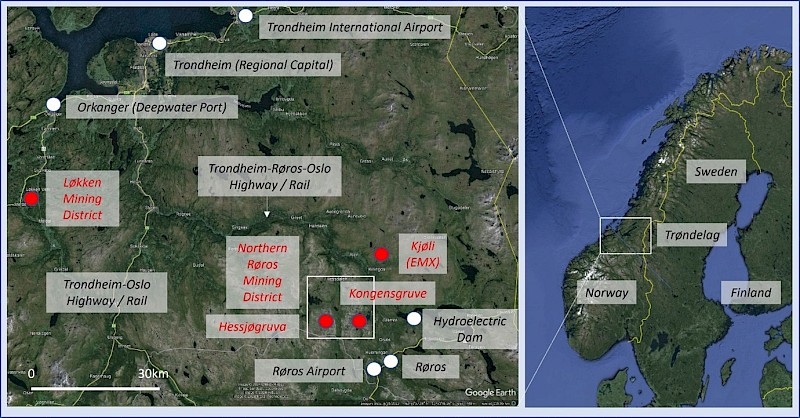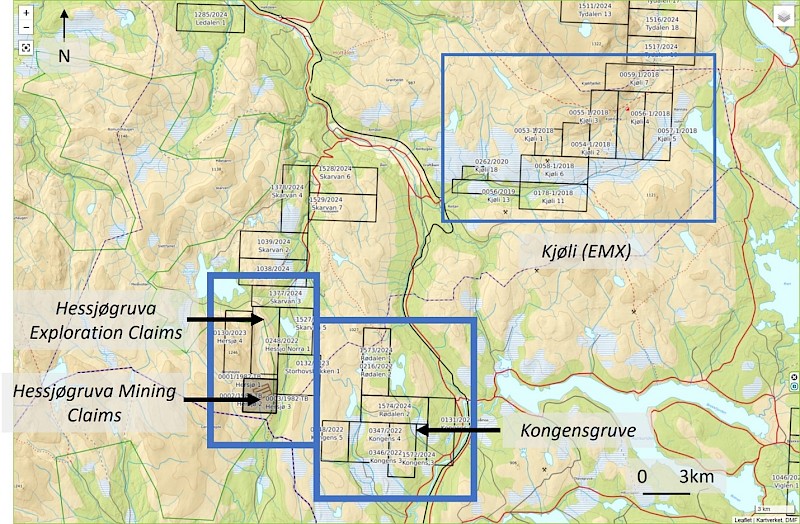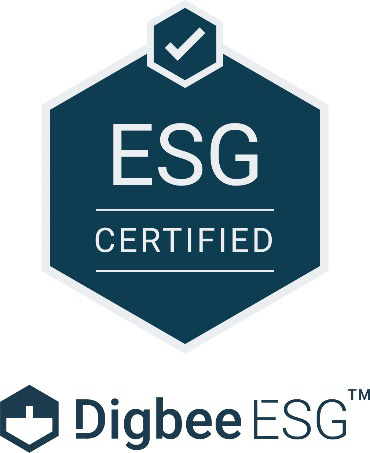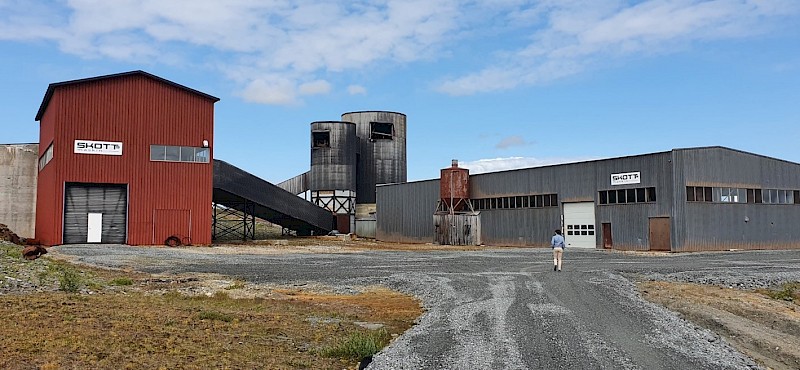Capella’s Hessjøgruva-Kongensgruve copper-cobalt-zinc project (Figures 1 & 2) is located in the northern part of the former Røros copper mining district of Trøndelag County, central Norway.
The cornerstone asset, Hessjøgruva, was acquired from local company Hessjøgruva AS on April 6, 2022, and is an advanced exploration-stage project with approximately 12,000m of core drilling dating from the 1970’s. Capella’s short-term goals for Hessjøgruva are to complete additional core drilling, report a Canadian National Instrument 43-101 (“NI 43-101”) compliant Mineral Resource Estimate, and to commencing initial project development studies.
The adjacent Kongensgruve claim blocks were staked by Capella and contain four known former copper mines (Rødalen, Kongensgruve, Fjellsjøen, and Muggruva) in addition to a former mineral processing facility and tailings dam at Kongensgruve.
Currently the Hessjøgruva-Kongensgruve Project forms part of the Tümad earn-in agreement which was announced on September 2, 2025, and includes funding for a minimum of 8,000m of diamond drilling to be completed on or before September, 2026
The Hessjøgruva-Kongensgruve project is favourably located with regards to infrastructure. Both the main Trondheim-Røros highway and railway line pass through the centre of the project area. Low-cost hydroelectric power is also readily available in the district.

Figure 1. Location of the Hessjøgruva-Kongensgruve project and local / regional infrastructure.

Figure 2. Locations of the principal target areas in the Hessjøgruva district.
Project Snapshot
| Location | 20km SE of Ålen, Trøndelag Province, central Norway |
| Ownership | 100% Capella Minerals Ltd Hessjøgruva: 2.5% NSR to Hessjøgruva AS, with 0.5% purchasable for Euro 1M Kongensgruve: no third-party NSR |
| Status | Exploration-stage |
| Deposit type | High-grade copper-rich VMS deposit |
| Host Rocks | Meta-volcanic and sedimentary sequences |
| Age | Cambro-Silurian, Ordovician orogeny |
| Main Economic Elements | Copper, Cobalt, Zinc (minor Silver, Gold) |
| Access | All weather paved highways and gravel roads |
Hessjøgruva Project
- Systematic exploration (including approximately 12,000m of core drilling) was completed at the Hessjøgruva project during the 1970’s by previous operators, including former local mining company Røros Kobberverk AS. Historical assaying was focused on copper and zinc; cobalt, silver, and gold were not routinely analyzed for.
- The copper-cobalt-zinc mineralization at Hessjøgruva is lenticular massive-sulfide (“VMS”)-type (Figure 3) and is identical to the mineralization type being targeted at Kongensgruve. The Hessjøgruva mineralization occurs primarily in three lenses (A-C, with Lens A hosting most of the high-grade mineralization; Figures 4 & 5), all of which extend from surface to >400m vertically below surface and all remain open down-dip. Mineralization is dominated by chalcopyrite, pyrite/pyrrhotite, and sphalerite, with copper content observed to increase with depth in the deposit.

Figure 3. Massive pyrrhotite-chalcopyrite mineralization at Hessjøgruva. Drill hole DDH-240, interval assays 1.7% Cu + 2% Zn + 0.1% Co.
- The average thickness of the highest-grade Lens A is approximately 10m1, with the thickest and highest-grade intercept reported from the historical drilling being 14.5m @ 4.35% Cu + 1.3% Zn (or 4.8% Cu equivalent2) (approximate true thickness) from 455.5m to 470m downhole in DDH-312. This mineralization remains open down dip.
- Capella announced the filing of an independent Canadian NI 43-101 compliant technical report for the Hessjøgruva project, in which all exploration activities to date have been summarized, on SEDAR (www.sedar.com) on September 8, 2022.
- Capella is currently in the process of applying for a new drill permit for 8,000m of diamond drilling to be completed during summer 2026. This drill program includes both infill and step-out drilling and is expected to lead on to an NI 43-101 compliant Mineral Resource Estimate for the project and to the commencement of initial development studies.
1 Geological Survey of Norway Report 2007.023; The Hersjø ore deposit, evaluation of ore potential.
2 Copper equivalent grades have been calculated using copper and zinc prices of USD 9,900/T and USD 3,700/T, respectively, with no adjustment having been made for metallurgical recovery as these are unknown at this time (metal price data: London Metal Exchange, www.lme.com).

Figure 4. Plan view of diamond drill-holes in high-grade copper-cobalt-zinc mineralization in Lens A, with the surface projection of mineralization shown in Figure 4 also indicated (source: Geometric and Qualimetric Modeling of the Hessjø deposit; Nørsett, S.J. 2016; NTNU M.Sc. Thesis).

Figure 5. Section showing high-grade copper-cobalt-zinc mineralization in Lens A (source: Geometric and Qualimetric Modeling of the Hessjø deposit; Nørsett, S.J. 2016; NTNU M.Sc. Thesis). Location of a potential future adit to access high-grade mineralized zones is also shown.
Terms of the Hessjøgruva Acquisition
Capella may acquire a 100% interest in the Hessjøgruva Cu-Zn-Co project in return for:
- Capella managing and funding exploration / development activities on the project.
- Capella paying Hessjøgruva AS a one-time amount of Euro 500,000 upon completion of a positive Bankable Feasibility Study.
- Capella providing Hessjøgruva AS with a 2.5% Net Smelter Royalty (“NSR”) on all future metal production from the project, retaining an option to buy-back 0.5% of this NSR at any time prior to the commencement of commercial production for Euro 1,000,000.
- Capella to cover the cost of annual property payments and basic administration costs.
Kongensgruve Project
Capella has successfully staked approximately 62 square kilometres of exploration claims over the past-producing Kongensgruve area. The central portion of the Kongensgruve claim block lies approximately 6km east of the Hessjøgruva project, contains a series of known copper-zinc-cobalt occurrences (including Rødalen, Kongensgruve, Fjellsjøen, and Muggruva), and also covers the site of a former mineral processing plant and tailings dam (Figures 6 & 7).

Figure 6. Overview of the Kongensgruve mining field (right hand photo) and an exposed lens of massive sulfide in chlorite schist (left hand photo).

Figure 7. Former Rødalen mine workings, Kongensgruve project.


